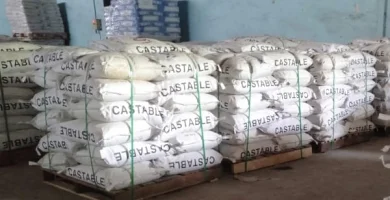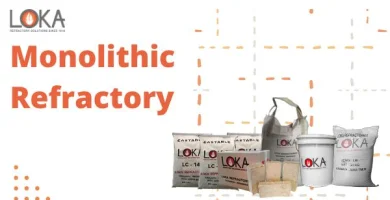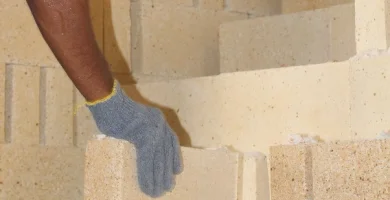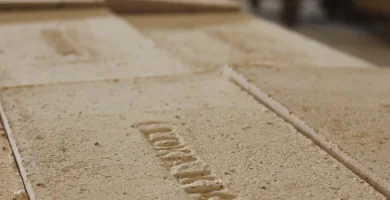 Get To Know About Castable Refractories!
Get To Know About Castable Refractories!Loka Refractories - Are you familiar with castable refractory? If not, you're in luck because this article will add to your knowledge about this material.
As discussed in the article Monolithic Refractory: Definition, Strengths, and Types, castable is a monolithic refractory that mixes raw materials and chemical binder using water and then forms it using a mold/cast.
Chemical binders that are often used are high alumina castable (HAC), hydratable alumina, and colloidal silica. Adding a chemical binder will form a ceramic bond after heating. Castable, which is also commonly called concrete refractory, is commonly used to coat furnaces, kilns, and so on.
Alumina and alumina silicate castables have been registered as SNI (Indonesian National Standard) products with SNI number 15-0809-2001. The two types of castable are classified as follows.
Classification of Alumina and Silicate Alumina Castable
1. Regular Castable
Regular castable has a hydraulic cement and CaO content of less than 2.5%. There are two types of regular castable based on MOR (Modulus of Rupture), namely normal type (MOR ≥ 300 psi) and high strength type (MOR ≥ 600 psi). Permanent linear shrinkage should not exceed 1.5% at fuel temperature.
2. Low Cement Castable
Castable with CaO content between 1-2.5%.
3. Ultra Low Cement Castable
Castable which has a CaO content of between 0.2-1%.
4. No Cement Castable
Castable which has a CaO content of less than 0.2% and comes from aggregates.
5. Insulating Castable
Insulating castable has the main function of producing thermal insulation. This type of castable has low density, low thermal conductivity, and has lower mechanical strength than ordinary castable. Permanent linear shrinkage should not be more than 1.5% at fuel temperature.
In addition, there are types of castable which are grouped based on the bonding process as follows.
Types of Castables based on Bonding Process
- Castables that harden at dry temperatures
Strong bonds and dense materials will be formed from the reaction of refractory grains with matrix materials in aqueous media. The matrix in question is refractory cement and phosphate.
- Castable which hardens at high temperatures
A strong bond is formed between the refractory grains and the matrix in the form of ceramic bond (clay) so that hardening occurs at relatively high temperatures.
Source: - Gupta, O.P. 2018. Elements of Chemical Process Technology. New Delhi: Khanna Book Publishing.
 Monolithic Refractory: Definition, Strengths, and Types
Monolithic Refractory: Definition, Strengths, and TypesLoka Refractories - Based on their shape, refractory materials are classified into shaped/brick refractory, unshaped/monolithic refractory, and fibrous material.
A brief explanation of the classification has been presented in a previous article entitled Refractory Classification: What Are Refractory Shapes?. In this article, we will focus on the explanation of monolithic refractories.
Want to add more insight of monolithic refractories? Check out the explanation from the definition to the type of product.
What is Monolithic Refractory?
Monolithic refractory, is a heat and flame resistant material that does not go through the process of forming by a press machine as well as burning before it reaches the consumer.
That's what makes this material do not have a definite shape, meaning that monolithic refractory can be formed or casted as desired when applied.
The Strengths of Monolithic Refractory over Shaped Refractory
One of the other forms of refractory is shaped refractory as opposed to monolithic, it has a definite shape. Compared to shaped, monolithic has several strengths including:
1. The absence of a regular connection is the weak point of shaped refractory products;
2. Faster to use and easier to handle and transport;
3. Better coverage to reduce downtime during maintenance;
4. Saving storage space because it does not have a definite shape;
5. More heat efficient;
6. More resistant to spalling or corrosion;
7. Has greater volume stability.
Application of Monolithic Refractory
Application of monolithic refractories are done by spraying, ramming, casting, or molding. This type of refractory is generally applied to fill gaps and adhesive refractory stones and linings.
Types of Monolithic Refractories
1. Castable
Castable is a type of refractory that mixes raw materials and chemical binder using water and then forms it using a mold/cast. Chemical binders that are often used are high alumina castable (HAC), hydratable alumina, and colloidal silica.
Adding a chemical binder will form a ceramic bond after heating. Another form of castable is Insulating castable which has the main function of producing thermal insulation. This type of castable has low density, low thermal conductivity, and has lower mechanical strength than ordinary castable.
2. Plastic Refractories
Plastic, is a monolithic refractory which is applied using a rammer without the need to prepare it first. Plastic refractories are distributed wrapped in polyethylene in a hard condition and form blocks.
3. Ramming mix
Ramming mix, which is a granular refractory which is strengthened by a ceramic bond arrangement after being heated. This material is similar to plastic refractory but harder. Just like plastic refractory, ramming mix is applied using a pneumatic rammer.
4. Mortar
Mortar is a material used as the adhesive of refractory bricks in a refractory lining. Initially, mortar did not include shaped nor unshaped refractory. There are three types of mortar, namely heat-setting, air-setting, and hydraulic setting.
5. Gunning
Gunning mix, which is a monolithic refractory material which is applied by spraying it on the surface or wall using various tools in the form of an air placement gun.
6. Slinger mix
Slinger mix, namely material that is applied using a slinger machine.
7. Patching and Coating Materials
This material has properties similar to mortar, but the grain size is more controlled making it suitable for patching and coating.
8. Light-weight castables
Refractory material produced by mixing hydraulic cement, a light and porous raw material, and water. Light-weight castables are molded and applied to the lining of furnaces, kilns, and so on.
Source:
- The Technical Association of Refractories, Japan. 1998. Refractories Handbook. Tokyo: The Technical Association of Refractories, Japan.
- Gupta, O.P. 2018. Elements of Chemical Process Technology. New Delhi: Khanna Book Publishing.
 Refractory Classification Based On The Raw Material's Properties
Refractory Classification Based On The Raw Material's Properties Refractory materials can be acidic, neutral or basic. This can be seen from its resistance to slag and atmosphere with these properties.
What materials fall into these three classifications? The following is an explanation of the type of refractory based on the nature of the ingredients.
Type of Refractory based on Material Properties
1. Acidic
Acidic refractory means that the material is resistant to acidic atmospheres of air and slag (pH 1-6). Examples of acid refractories are: Silica, Zirconia, and Alumino-silicate.
2. Neutral
If the refractory material is resistant to both acid and alkaline conditions (pH 7), it means that it is neutral. Neutral refractory materials, namely: Alumina, Carbon containing, and Chromite.
3. Basic
A refractory material that is resistant to basic atmospheres and slag (pH 8-14) means that the material is alkaline. Examples of basic refractories are: Magnesite, Dolomite, and Magnesite chrome.
There you have it! Those are the explanation of the types of refractories based on the properties of the ingredients they contain.
 Refractory Classification: What Are Refractory Shapes?
Refractory Classification: What Are Refractory Shapes?There are various types of refractories and are classified into several groups. One of them is based on shape.
According to the shape, the refractory material consists of shaped refractories, unshaped refractories, and fibrous material.
Types of Refractory Based on Shape
1. Shaped refractories
Shaped refractories are refractory materials that go through a forming process with a high pressure press machine so that they have a definite shape.
Typically, shaped refractories or also known as bricks are applied to furnaces, kilns, glass tanks, or lining incinerators.
2. Unshaped refractories
In contrast to shaped refractories, unshaped refractories do not go through a process of forming with a press machine so they don't have a definite shape.
Unshaped refractories or can also be called monolithic refractories have several types including Mortar, Castable, Plastic, Gunning and Ramming Mix, and many more.
3. Fibrous Material
Ceramic fiber, a type of fibrous material are refractory materials in the form of synthetic fibers. Several kinds of fibrous materials include blankets, felt, modules, vacuum forms, rope and loose fiber.
Special Shaped Refractory
Thus the type of refractory based on shape. But, those aren't the only existing refractory shapes.
In fact, there are refractory materials that have customized shapes based on the industries' requirements.
Where could we find customized shaped refractories, you ask?
Loka Refractories is here to supply the industries' need of shaped, unshaped, even special refractories!
Call us!
Loka Refractories
E-mail : info@lokarefractories.com
Phone : 031-7663307
Whatsapp : 0821-4280-8500
Pemilihan dan penerapan peralatan produksi papan kalsium silikat
Peralatan melonggarkan serat (dibagi menjadi melonggarkan asbes dan melonggarkan serat kertas): sebagian besar peralatan melonggarkan asbes adalah peralatan penggilingan vertikal dan roda. Peralatan penggilingan roda lebih baik, tetapi tidak praktis untuk digunakan; Melonggarkan vertikal relatif sederhana. Peralatan pembuatan kertas terutama digunakan untuk melonggarkan pulp. Baik serat asbes dan serat kertas harus dilonggarkan sepenuhnya, jika tidak, tingkat pemanfaatan serat akan sangat berkurang. Jika 10% dari serat gagal dilonggarkan, biayanya 10% lebih banyak dari total serat dalam satu tahun. Limbah tersebut tentunya akan banyak jumlahnya dan juga akan mempengaruhi kualitas tampilan papan tersebut.
Stacker dan demoulder: peralatan terkait yang diimpor dari luar negeri memang memiliki kualitas yang lebih tinggi daripada peralatan dalam negeri. Tentu saja, ada produk yang ditingkatkan di Cina, seperti portabel, silinder pneumatik naik turun (tidak bergantung pada pengurangan berat sendiri), dll. Kipas spiral digunakan sebagai daya pelat hisap, dan cangkir hisap pelat yang lebih canggih digunakan (cepat dan lampu). Gunakan encoder untuk mengontrol troli cangkir hisap untuk menumpuk pelat laminasi (bekisting) dengan rapi. Ketika siklus berjalan cangkir hisap dipercepat, lift tidak dapat digunakan, yang dapat mengurangi biaya produksi dan meningkatkan lingkungan kerja. Seluruh rangkaian stacker tidak memiliki kebocoran oli tanpa stasiun hidrolik. Konsumsi daya berkurang dari sekitar 20kW (dilengkapi dengan dua elevator) menjadi sekitar 4kw. Peningkatan kecepatan stacker kondusif untuk peningkatan output mesin pembuat pelat (kadang-kadang merupakan faktor penting).
Autoclave: saat menggunakan autoclave, perhatikan pemilihan pintu atas dan pintu ganda depan dan belakang. Autoclave menggunakan metode pembukaan pintu atas, yang menempati area kecil; Pintu ganda depan dan belakang dapat memungkinkan mobil palet masuk dari satu sisi dan keluar dari sisi lain. Sebelum memasuki ketel, panjang total gerbong palet satu ketel (sedikit lebih panjang dari panjang autoklaf) harus cukup, dan panjang ketel harus sama. Dengan cara ini, seluruh rangkaian troli dapat masuk dan keluar pada satu waktu, yang dapat sangat meningkatkan tingkat pemanfaatan autoklaf dan mengurangi intensitas tenaga kerja pekerja. Beberapa pabrik baru tidak memahami pentingnya, Oleh karena itu, kerugian yang tidak perlu terjadi.
Steam curing trolley: biasanya trolley steam curing merupakan alat transportasi yang tidak terlalu diperhatikan. Namun, jika tidak digunakan dengan benar dan ditangani dengan benar, hal itu akan menyebabkan masalah berkelanjutan di masa depan, dan konsekuensi yang sangat serius akan menyebabkan kerusakan bantalan. Oleh karena itu, disarankan untuk menggunakan bantalan suhu tinggi sebanyak mungkin, sehingga tidak perlu mengisi bahan bakar setiap kali memasuki autoklaf, dan efek penggunaan sebenarnya juga cukup baik. Jika benar-benar perlu menggunakan bantalan biasa, sedikit oli mesin harus ditambahkan setiap kali setelah keluar dari ketel (Catatan: jangan memasukkan minyak pelumas gemuk). Selain itu, saat membuat troli, pastikan sumbu ganda roda empat sejajar dan simetris, dan rangkanya harus dibuat dari profil pabrik yang besar. Dalam produksi aktual, ditemukan bahwa profil non-standar akan teroksidasi serius setelah digunakan dalam ketel berkali-kali.
Pengering garpu rantai telah banyak digunakan dalam beberapa tahun terakhir. Dilengkapi dengan peralatan yang sesuai, proses dari pengeringan hingga tepi, penyemprotan merek dagang dan penumpukan dapat sepenuhnya otomatis.
Ada contoh seperti itu: platform perputaran → akumulator pelat → dalam pengering → pengering keluar, mesin tepi → mesin resolusi produk positif dan negatif (terutama ketebalan). Susun asli, susun negatif. Cabang dapat memasuki sander, dan seluruh proses sepenuhnya otomatis, yang mengurangi pengangkutan dan penumpukan pelat, menghemat tenaga kerja dan mengurangi kerugian.
Platform perputaran: untuk memutar pelat yang melewati pengering rantai lagi untuk menjaga permukaan pelat tetap ke atas.
Akumulator pelat: digunakan untuk mengatur dan melengkapi ketika akan ada pelat yang hilang di tengah proses ketika pelat pada troli dilepas, untuk memastikan tidak ada kekosongan dalam proses produksi.
Pengering: pengering telah membuat kemajuan besar dalam kinerja setelah bertahun-tahun digunakan dan berlatih. Sumber panas pengering dapat dibagi menjadi beberapa jenis: langsung membakar solar atau gas, menghasilkan uap melalui boiler, kemudian menggunakan radiator, dan menggunakan minyak panas. Beberapa metode memiliki karakteristik masing-masing: misalnya, ekonomis untuk membakar batubara di pabrik untuk menghasilkan uap atau minyak perpindahan panas sebagai sumber panas. Biaya penggunaan minyak transfer panas lebih rendah daripada uap, tetapi investasi pada tahap awal lebih besar; Jika pembangkit tidak dapat membakar batu bara dan tidak ada uap eksternal untuk membakar boiler diesel, maka akan menghemat energi dengan membakar langsung solar atau gas sebagai sumber panas. Saat ini, pembakaran batubara banyak digunakan di industri dalam negeri untuk menghasilkan uap untuk autoklaf dan pengering.
Dalam hal efisiensi termal, struktur pengeringan menggunakan gas panas untuk membuat sirkulasi aliran internal antara badan pelat dan badan pelat, sehingga dapat mengubah pemborosan energi sebelumnya di sirkulasi atas dan luar dan meningkatkan efisiensi termalnya. Metode penghilangan kelembaban yang lebih rendah digunakan untuk menghindari pemborosan yang disebabkan oleh pelepasan sejumlah besar energi panas bersama-sama ketika kelembaban atas dihilangkan. Untuk membuat penggunaan energi panas lebih efektif, dinding luar pengering dapat dibuat menjadi interlayer, dan energi panas di interlayer dapat ditransfer ke kipas pemanas untuk pemanfaatan. Melalui langkah-langkah di atas, pelat kering dapat dipanaskan secara merata dan efisiensi termal seluruh pengering dapat ditingkatkan.
Mesin merayap: mesin tepi roda berlian yang banyak digunakan di industri saat ini memiliki keunggulan biaya alat yang rendah, penampilan yang rapi setelah penggilingan dan tingkat kerusakan yang lebih sedikit. Itu dapat mewujudkan perawatan talang besar atau talang kecil di tepi pelat sesuai kebutuhan. Ini dapat sepenuhnya otomatis sebelum dan sesudah penggilingan, sehingga pabrikan dapat menangani tampilan pelat (terutama mengacu pada empat tepi).
Mesin slitting: sekarang, mesin slitting otomatis (sekitar 2440) × 1220 atau 3050 × 1220 pelat besar dibagi menjadi beberapa pelat strip panjang) dan mesin pemisah pelat otomatis (sekitar 2440 × 1220 pelat besar dibagi menjadi 600 × 600 atau 300 × 300 pelat kecil) telah diterapkan secara bertahap di beberapa pabrikan, membuat setiap pabrikan lebih aktif dan bebas dalam pemrosesan pelat lebih lanjut.
Sumber : http://m.id.greenergyrefractarios.com/news/selection-and-application-of-calcium-silicate-51229742.html


